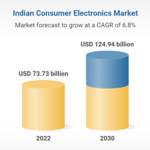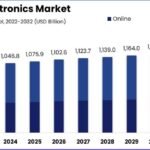The global electronic components market is projected to reach a staggering $847.88 billion by 2032, driven by rapid technological advancements, increasing demand for smart devices, and the growing integration of electronics across various industries. This substantial market growth reflects the ongoing digital transformation in sectors such as automotive, telecommunications, consumer electronics, medical devices, and industrial automation. With smart technologies, 5G networks, and Internet of Things (IoT) innovations at the forefront, the demand for electronic components is expected to surge significantly in the coming years.
A key factor contributing to this growth is the increasing adoption of electronic components in automotive technologies, including electric vehicles (EVs), autonomous driving systems, and advanced driver-assistance systems (ADAS). Additionally, the consumer electronics market, driven by the smartphone, wearable devices, smart home systems, and entertainment products, will continue to expand as technology evolves. This demand is further fueled by the widespread use of LED lighting, power electronics, and high-performance semiconductors, which are crucial for driving innovation in smart technologies.
The Asia-Pacific region is expected to lead the growth of the electronic components market, with countries such as China, Japan, and South Korea serving as key manufacturing hubs. India is also emerging as a significant player, particularly in electronics manufacturing, as companies look to diversify their supply chains and reduce dependency on China. Governments in regions like India and Southeast Asia are actively promoting electronics manufacturing through initiatives like Make in India and Atmanirbhar Bharat, which are boosting domestic production and attracting foreign investment in the sector. This trend is expected to accelerate as demand for semiconductors, microchips, and other critical components increases.
Technological innovations, such as the development of flexible electronics, 5G components, and advanced semiconductor materials, will also play a vital role in shaping the future of the electronic components market. These innovations are likely to improve the performance and energy efficiency of devices, further driving the adoption of electronic components across industries. Moreover, the increasing emphasis on sustainability and the need for green electronics will propel the demand for energy-efficient components, supporting the market’s growth.
As the global economy recovers and industries continue to invest in new technologies, the electronic components market is expected to witness a dynamic period of growth, with strong demand across consumer electronics, industrial applications, and emerging technologies. With the market set to surpass $847.88 billion by 2032, businesses involved in the production and distribution of electronic components will need to innovate, adapt to changing consumer needs, and invest in advanced manufacturing processes to maintain their competitive edge in this thriving sector.














